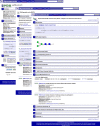Glycosciences.DB: an annotated data collection linking glycomics and proteomics data (2018 update)
- PMID: 30357361
- PMCID: PMC6323918
- DOI: 10.1093/nar/gky994
Glycosciences.DB: an annotated data collection linking glycomics and proteomics data (2018 update)
Abstract
Glycosciences.DB, the glycan structure database of the Glycosciences.de portal, collects various kinds of data on glycan structures, including carbohydrate moieties from worldwide Protein Data Bank (wwPDB) structures. This way it forms a bridge between glycomics and proteomics resources. A major update of this database combines a redesigned web interface with a series of new functions. These include separate entry pages not only for glycan structures but also for literature references and wwPDB entries, improved substructure search options, a newly available keyword search covering all types of entries in one query, and new types of information that is added to glycan structures. These new features are described in detail in this article, and options how users can provide information to the database are discussed as well. Glycosciences.DB is available at http://www.glycosciences.de/database/ and can be freely accessed.
Figures




References
-
- Lauc G., Pezer M., Rudan I., Campbell H.. Mechanisms of disease: the human N-glycome. Biochim. Biophys. Acta. 2016; 1860:1574–1582. - PubMed
MeSH terms
Substances
LinkOut - more resources
Full Text Sources
Miscellaneous

